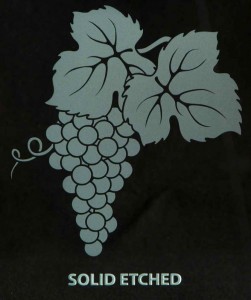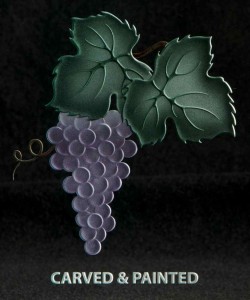Etched Glass, Carved Glass. What do you mean?
The term “etched glass” can have a number of different meanings, pointing to a number of different “etching techniques”.
Most people have a basic picture in their minds when they hear the term “etched glass” .. basically visualizing that the glass surface has been turned white! It’s no longer “clear”. This is true, it’s just that there are a number of different techniques that can be used to achieve this effect, AND there’s a number of different effects or “looks” of etched glass, all different, but all falling under the definition “etched glass”.
“Etched glass” is a generic term for the treatment of the glass surface to diffuse transmitted light, reduce glare and give the glass a white, frosted appearance. A couple detailed definitions include:
“Glass decorated through the process of sandblasting or the use of hydroflouroc acid”. (source picassomio.com).
“A type of glassware whose decorative design has been cut into the surface by the corrosive action of an acid. An etched-glass surface may be either rough and frosted or satiny smooth and translucent, depending largely on the composition of the glass and the amount of time the glass is exposed to the acid.” (source britannica.com).
Another term that’s basically interchangeable with “etched glass”, is the term frosted glass.
The method used by Sans Soucie for frosted or etched glass, is sandblasting, whereby we are etching the surface of the glass by spraying it with compressed air and sand. It takes a very gifted and well trained hand to be able to achieve a level of quality in the art of sandblasted glass!
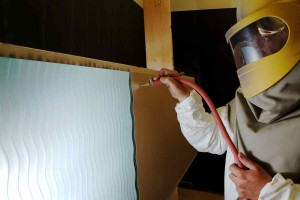
But then there’s further meaning for us, as we describe our sandblast techniques and effects. When we use the term “etched”, we really mean “surface etched”, where we have sandblasted the glass enough to effect the “surface only”. “Etching” does not go deep into the glass and creates a one-dimensional effect.
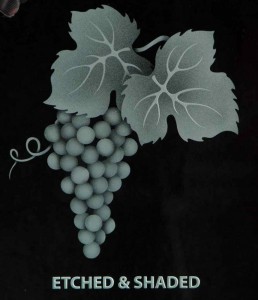
When we “go deeper” into the glass, we call that “carving” or “sculpture carving” the glass. Carving means we have sandblasted DEEPER into the glass surface, creating a three-dimensional sculpted image, carving a relief design which is a much more detailed effect, obtaining differing depths within the carved image. The carved EDGES within the design image will actually appear whiter and brighter, as they pick up and reflect the surrounding light. The image will appear three dimensional, as if it is floating within the glass.
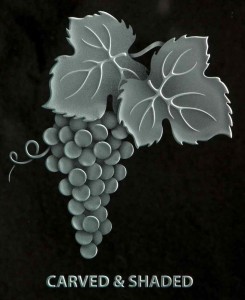
Another, more basic method or really more common “etched glass is look” is called a “solid etch”. This is a “single stage sandblast” technique, where there is no “shading” (shading is the term we use for leaving clear areas within the design). And by the way, this is the ONLY effect that can be achieved through other means of etching, such as acid or laser etching. This is where the design is a “solid white”, if you will. The effect is one-dimensional and does not create any “depth” or dimension in the design.
Another technique or effect that Sans Soucie glass features, is adding color to the glass design. This of course adds a dramatic element and since any color can be applied, this allows for a limitless, custom feature of our glass.
For more information about techniques and effects, as well other commonly asked questions, visit our FAQ’s page on our web site!
